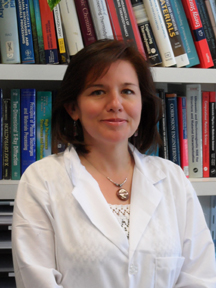September 11, 2013 - Energy Academic Group
Tailored Nanomaterial Electrodes for Energy Storage Applications
September 11, 2013
ME Auditorium
1200
Dr. Claudia C. Luhrs
Associate Professor
Department of Mechanical and Aerospace Engineering
Graduate School of Engineering and Applied Sciences
Naval Postgraduate School
Student Presentation
LCDR Timothy Householder
Physics Student
Naval Postgraduate School
(Information below)
Abstract
Given the unique characteristics found in materials at the nanoscale, such as high surface areas and enlarged reactivities, their use opens a window of new properties and opportunities in the energy storage field. However, such materials need to be designed with distinct structural features and created for particular set of working conditions. Creating tailor made high energy density nanomaterials could only be achieved by following adequate generation pathways. This presentation is focused on the strategies employed by our group to engineer nanoparticulates for battery and supercapacitor electrode applications. The techniques described herein include plasma methodologies, chemical approaches and reduction-expansion synthesis. Unique metal/carbon, carbon fibers, graphene and doped graphene electrodes, along the materials characterization and results from their testing, are presented.
Biography
In April 2011 Claudia C. Luhrs was appointed Associate Professor of the Mechanical and Aerospace Engineering Department at the Naval Postgraduate School, in Monterey, California. From 2008-2011 Dr. Luhrs held an Assistant Professor position in the Mechanical Engineering Department at the University of New Mexico, Albuquerque, NM. Prior to UNM, she worked as a Staff Engineer for Intel Corporation, Fab11X, New Mexico site. Prof. Luhrs received her PhD degree from Autonomous University of Barcelona, while conducting her thesis work at the Barcelona Materials Science Institute (Spain, 1997).
Dr. Luhrs research interests focus on nanostructured functional materials, in particular, tailored synthetic pathways for their preparation (i.e. chemical and plasma/aerosol methodologies) and the characterization of their crystal structures. Her work aims to understand the correlations between structural features and the materials reactivity, thermal, electrical and mechanical properties.
Her research experience includes studies of complex oxide ceramic structures and the generation and application of nanosized metal, ceramic/metal and metal/carbon particulates. In recent years her work has been extended to include novel pathways to fabricate carbon based nanomaterials; from carbon nanofibers, nanotubes and graphene, to their hybrids and composites. Application projects with Naval relevance include the generation of thermally stable materials for catalysts, gas sensors, batteries, supercapacitors and structural composites.
Dr. Luhrs has more than 15 years of experience teaching courses both to academic and industrial audiences, at undergraduate and graduate levels in areas related to Materials Science and Engineering with emphasis in nanosystems and devices. She has more than 38 international peer reviewed journal publications, 40 presentations in specialized scientific meetings, has advised more than 15 student theses, has 3 issued patents and another 14 filed.
Piezoelectricity is the mechanism by which certain crystalline structures generate electric potential when under strain; or, conversely, deform when subjected to an electric potential. Simulations have shown it is possible to harvest waste energy to power small electronic devices by developing a piezoelectric microelectromechanical system (MEMS). This thesis will complete the remaining microfabrication techniques to complete the device. It will also test and refine fabrication techniques for vibrationally-actuating piezoelectric MEMS devices developed in the previous thesi. Finally, it will feedback experimental results to optimize the models previously developed. These MEMS devices may be tuned for 60 or 50Hz, to return waste energy from US or foreign electrical distribution systems, or can be designed for a swath of resonant frequencies for bulk energy harvesting.
MEMS-Based Waste Vibrational Energy Harvesters
September 11, 2013
ME Auditorium
1200
LCDR Tim Householder
Physics Student
Naval Postgraduate School
Abstract
Piezoelectricity is the mechanism by which certain crystalline structures generate electric potential when under strain; or, conversely, deform when subjected to an electric potential. Simulations have shown it is possible to harvest waste energy to power small electronic devices by developing a piezoelectric microelectromechanical system (MEMS). This thesis will complete the remaining microfabrication techniques to complete the device. It will also test and refine fabrication techniques for vibrationally-actuating piezoelectric MEMS devices developed in the previous thesi. Finally, it will feedback experimental results to optimize the models previously developed. These MEMS devices may be tuned for 60 or 50Hz, to return waste energy from US or foreign electrical distribution systems, or can be designed for a swath of resonant frequencies for bulk energy harvesting.
Biography
LCDR Tim Householder, a Southern California native, is a Combat Systems student working towards a MS Physics. A 16-year veteran of the Submarine Service, LCDR Householder recently accepted redesignation into the Engineering Duty Officer community. His various duty stations include operational tours on three submarines, a destroyer squadron, and submarine rescue; as well as various training and administrative commands. LCDR Householder received his BS in Mathematics in 2002 from the University of Idaho, where he built a lab for Raman Spectroscopy (Materials Research Society Proceedings, 2002). LCDR Householder is qualified in Submarine Warfare, Deep Submergence, Nuclear Engineering, and Strategic Weapons; his awards include the Naval Submarine League Outstanding Achievement Award, multiple Navy Commendation and Achievement Medals, and various unit and campaign awards. He is active in the NPS band, Del Monte Brass, and volunteers with various tutoring and speaking engagements.
POC
Dr. Daniel A. Nussbaum
Naval Postgraduate School
Principal, Energy Academic Group
Monterey CA 93943
Phone: 831-656-2387
Mobile: 831-324-3228
Email: dnussbaum@nps.edu
Related Resources
Dr. Luhrs Information
LCDR Householder Information
(NPS Signin Required)


